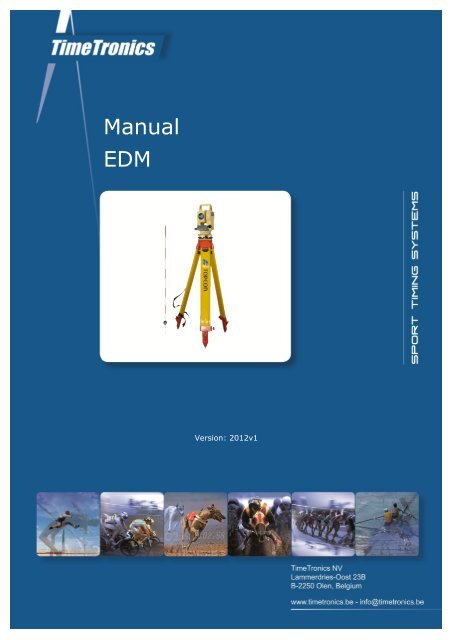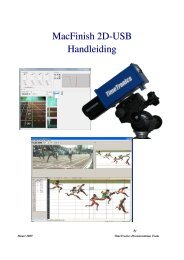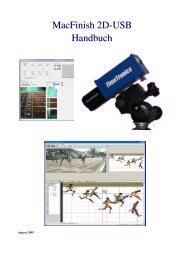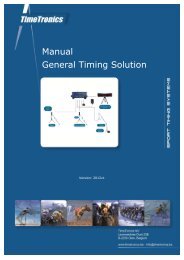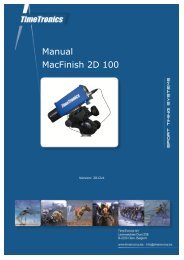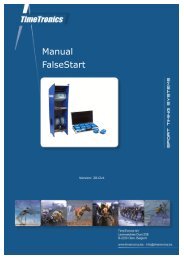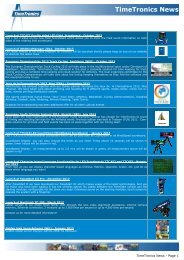Manual EDM
Manual EDM - TimeTronics
Manual EDM - TimeTronics
- No tags were found...
Create successful ePaper yourself
Turn your PDF publications into a flip-book with our unique Google optimized e-Paper software.
<strong>Manual</strong><br />
<strong>EDM</strong><br />
Version: 2012v1
Table of Contents<br />
PREFACE......................................................................................................2<br />
1. INTRODUCTION.......................................................................................3<br />
2. SCHEMATIC SURVEY & CONFIGURATION CONTENTS..............................3<br />
3. OPERATING PRINCIPLE...........................................................................3<br />
4. USING THE TOPCON LASER.....................................................................4<br />
4.1. Initialization...............................................................................................................4<br />
4.1.1. Positioning...........................................................................................................4<br />
4.1.2 Spirit Level...........................................................................................................4<br />
4.1.3 Powering up the Topcon Laser.................................................................................5<br />
4.2. Performing a Measurement...........................................................................................5<br />
4.2.1 Positioning the (Prism) Reflector..............................................................................5<br />
4.2.2 Directing the laser to the prism reflector..................................................................6<br />
4.2.3 Actual Laser Measurement......................................................................................6<br />
5. SOFTWARE..............................................................................................6<br />
5.1. Installation and startup................................................................................................6<br />
5.2. LaserCalculation “File”-Menu.........................................................................................7<br />
5.3. Initialization and calibration of the laser calculation software............................................7<br />
5.3.1 Calibration of horizontal throws: javelin, discus, shot put, hammer..................................7<br />
5.3.2 Calibration of horizontal jumps: long jump and triple jump.........................................8<br />
5.3.3 Calibration of vertical jumps: high jump and pole vault..............................................9<br />
5.4. Performing the actual measurements.............................................................................9<br />
5.5. Display and printing the loggings..................................................................................9<br />
APPENDIX 1: LASER SOFTWARE SERIAL OUT PROTOCOL..........................10<br />
TimeTronics NV<br />
Lammerdries-Oost 23B<br />
B-2250, Belgium<br />
Tel +32 (0)14 23 19 11<br />
Fax +32 (0)14 23 20 24<br />
VAT BE0440 224 404<br />
HR Turnhout 64540<br />
KBC Bank 414-4191871-52<br />
SWIFT : KREDBE22<br />
IBAN : BE64 4144 1918 7152<br />
www.timetronics.be
2012v1 <strong>Manual</strong> Electronic Distance & Height Measurement (<strong>EDM</strong>)<br />
PREFACE<br />
Welcome to the "Electronic Distance & Height Measurement (<strong>EDM</strong>)" user<br />
manual.<br />
May we recommend you to gently leaf through the entire manual first, just to have an initial idea of how the book is<br />
structured. As we cannot possibly explain all details simultaneously, this might help you a bit in understanding and tracing<br />
things back. Of course, the table of contents will also help you in doing so.<br />
Please note that all pictures are examples, the delivered version can be different than shown in this manual please inform<br />
yourself before purchase.<br />
If you, after reading this document, have any further question regarding the operation or service of this or any other<br />
TimeTronics equipment, please contact your local distributor or TimeTronics directly, by email: info@timetronics.be, or call<br />
us at +32 (0) 14 23 19 11<br />
Please also contact us if you have any remarks or advise regarding this user manual: info@timetronics.be.<br />
Good luck with your Electronic Distance & Height Measurement (<strong>EDM</strong>) and thank you for your confidence in the<br />
TimeTronics products and services.<br />
The editors.<br />
© Copyright 2012 TimeTronics. All rights reserved.<br />
TimeTronics<br />
Lammerdries 23b<br />
B-2250 Olen<br />
Belgium<br />
Tel.: +32 (0) 14 23 19 11<br />
Disclaimer<br />
Under no circumstances shall TimeTronics be liable for any loss, damage or expense suffered or incurred with respect to<br />
any defective product. In no event shall TimeTronics be liable for any incidental or consequential damages that you may<br />
suffer directly or indirectly from use of any product. Windows, Windows XP and Windows VISTA are registered trademarks<br />
of Microsoft Corporation.<br />
2
2012v1 <strong>Manual</strong> Electronic Distance & Height Measurement (<strong>EDM</strong>)<br />
1. INTRODUCTION<br />
The Laser distance measuring system can be used in athletics for javelin throwing, discus throwing, hammer throwing,<br />
shot put, long jump, triple jump, and pole vault.<br />
The laser equipment does the distance and angle measurement. The real result in athletics is obtained by:<br />
a) A PC windows program, see chapter 5<br />
b) The Field Terminal in combination with the AthleticsManager program.<br />
Field Terminal and AthleticsManager are described in other manuals.<br />
2. SCHEMATIC SURVEY & CONFIGURATION CONTENTS<br />
Please find subsequent elements in your configuration:<br />
- Laser distance measurement instrument (with build-in battery) on tripod, +<br />
carrying case + cable.<br />
- Prism reflector on small pole.<br />
- Mobile caddy on wheels with build-in portable PC with Laser Calculation<br />
(LCxx) software<br />
The Topcon laser distance measuring system is power supplied via the build-in battery<br />
pack. The portable pc can work a limited time on its internal battery, but long<br />
operation (e.g. a full day), can only be done if the 220vac/110Vac power adapter is<br />
used.<br />
3. OPERATING PRINCIPLE<br />
EXAMPLE: SHOT PUT (also see schematic representation)<br />
Before the start of the event, the Topcon laser first measures:<br />
- Distance ‘A’ (= distance between the centre point of the throwing sector and the position of the Topcon)<br />
- Angle ‘a’ (= the relative angle (direction))<br />
After each athlete’s attempt, the distance between the point of impact (= point of positioning the reflector) and the Topcon<br />
laser (=’B’) and the relative angle ‘b’ are measured by means of the laser system.<br />
Now the angle ‘C’ (= b minus a) can be calculated.<br />
Through the principle of trigonometry, the instrument automatically calculates the distance between the centre point of<br />
the throwing circle and the point of impact (D).<br />
Subsequently, 1/2 diameter of the throwing circle is subtracted from this distance. That way we obtain the final result (R).<br />
The distance, which is subtracted from ‘D’, is a variable in the software and is dependent on the athletic event in question.<br />
3
2012v1 <strong>Manual</strong> Electronic Distance & Height Measurement (<strong>EDM</strong>)<br />
4. USING THE TOPCON LASER<br />
Further in this manual we will refer to the numbers visible on the drawing below:<br />
4.1. Initialization<br />
4.1.1. Positioning<br />
Find a safe and practical location to position the Topcon laser at a random side of the throwing sector or jumping area. Be<br />
sure that you have a clear view over the TOTAL landing area, in other words that there will be no obstructions (like poles,<br />
scoreboards, persons,...) between the laser and the future landing points which could disturb a practical measurement. Do<br />
not put the laser ‘as close as possible’ to the landing area, for safety reasons, but it is also faster and easier to put the<br />
laser system minimum 10 meters away from the landing area, because you will then have less work to focus the eyepiece<br />
for each jump or throw.<br />
4.1.2 Spirit Level<br />
Please make sure that the (6) circular spirit level on the base plate (10) of the Topcon laser is in correct position.<br />
To tune the spirit level, please first use the three screws (9) on the very same base.<br />
4
2012v1 <strong>Manual</strong> Electronic Distance & Height Measurement (<strong>EDM</strong>)<br />
After you have tuned the (6) circular spirit level as good as possible, finetune the laser spirit level in the following way:<br />
Use the (9) leveling screws “A” and “C” to adjust the plate level (12) so that the ‘air bubble’ is exactly in the middle.<br />
Now rotate the instrument 90 ° and use only the (9) leveling screw “B” to adjust the plate level (12) so that the ‘air<br />
bubble’ is exactly in the middle.<br />
4.1.3 Powering up the Topcon Laser<br />
Check that the on board battery (2) is placed on the laser<br />
instrument. Connect the Topcon serial connector (8) to the<br />
mobile caddy by means of the special cable, supplied with the<br />
system. Press the ‘POWER’ button (26) on the front panel of<br />
the Topcon laser:<br />
On the Topcon laser’s display window, you will see the welcome<br />
message “Topcon GTS-220”.<br />
If not already so, press the button (29) until you see the following<br />
“Angular measurement mode”, visible on the first three lines of<br />
the LCD display (V=vert.angle/HR=Horiz. angle/SD=slope<br />
distance):<br />
Do not use the button (30) for “coordinate measurement<br />
mode”, as this will give you no result calculation in the current software.<br />
4.2. Performing a Measurement<br />
4.2.1 Positioning the (Prism) Reflector<br />
Screw the prism reflector onto the little pole as low as possible. For a first test,<br />
position the reflector on the center of the throwing circle or somewhere in the field.<br />
Make always sure that the spirit level on the reflector is correct when you place it in<br />
position.<br />
5
2012v1 <strong>Manual</strong> Electronic Distance & Height Measurement (<strong>EDM</strong>)<br />
4.2.2 Directing the laser to the prism reflector<br />
We first unlock the laser direction by means of screws (4) and (14). We<br />
make a raw estimation of the direction by looking through the small<br />
telescopic collimator (17) on top of the Topcon laser. Try to direct the<br />
triangle within this tube approximately ten centimeters above the prism<br />
reflector in the field.<br />
Then lock the Topcon laser with BOTH screws (4) and (14). We now look<br />
through the eyepiece (15) of the Topcon laser and try to track down the<br />
reflector in the heart of the eye. You can focus the eye by turning the ring<br />
(16) around the eye.<br />
When the eye of the Topcon laser is pointed to the prism reflector, you<br />
can optionally hear a buzzing sound.<br />
We now fine tune the laser direction by means of the controls (5) and<br />
(13).<br />
4.2.3 Actual Laser Measurement<br />
You perform the actual laser measurement by pressing the “ESC” button (27).<br />
This button will perform the laser measurement, but will NOT YET send the measurement data towards the computer.<br />
After the measurement you will see the text “>REC ? [YES] [NO]” on line 4 of the LCD display, and you can send the data<br />
to the computer by means of the [YES] action = the “F3” button (23).<br />
Example: On the display, you could see the HR (horizontal angle 28°30’50”), V<br />
(vertical angle 90°56’25”) and SD (Slope Distance 32,003m):<br />
You can now unlock the Topcon laser again by means of screws (4) and (14) and put it out of position (which will stop the<br />
optional buzzer sound).<br />
The operator (or official) with the prism mirror can now be informed that the measurement is completed, so that he can<br />
move away from the throwing area, to allow the next athlete to compete.<br />
The PC software will record the transmitted data, and calculate and display the required distance or height result,<br />
depending on the selected athletic event.<br />
5. SOFTWARE<br />
5.1. Installation and startup<br />
Copy the “LCxx” software folder (for example LC06 where xx is the latest version<br />
number 06) from the TimeTronics cd to your harddisk “C” of your computer.<br />
Start now the (application) ‘LCxx.EXE’ (=LaserCalculation program), which you have<br />
placed on your harddisk, by double clicking its icon. The first time that you start the<br />
program, it will ask you for a suitable data file. Just press the “NEW” button, and give a<br />
name and location for the new datafile, for example “LC datafile”. You now see the<br />
background screen of the program, with the ‘TimeTronics’ logo.<br />
6
2012v1 <strong>Manual</strong> Electronic Distance & Height Measurement (<strong>EDM</strong>)<br />
5.2. LaserCalculation “File”-Menu<br />
The “File” menu has two items:<br />
1) List of loggings; this gives a (printable) list of all logged data, including calibration data.<br />
2) Quit: to be used to end the program.<br />
5.3. Initialization and calibration of the laser calculation software<br />
The “Measurements” menu has 3 items:<br />
5.3.1. Javelin, discus, shot put, hammer<br />
5.3.2. Long and Triple Jump<br />
5.3.3. High Jump and Pole Vault<br />
5.3.1 Calibration of horizontal throws: javelin, discus, shot put, hammer<br />
For the calibration of horizontal<br />
throwing events (javelin,<br />
discus, shot put, hammer<br />
throwing,...) , we will have to<br />
measure one reference point<br />
( the ‘centre point’ of the<br />
throwing circle) BEFORE the<br />
start of the athletic event.<br />
One person will place the point<br />
of the small bar with the prism<br />
mirror exactly in the centre of<br />
the throwing circle, the laser<br />
operator will align the laser eye<br />
to the centre of the prism and<br />
perform a measurement with<br />
the “ESC” key (27) + the “F3”<br />
key (23) of the Topcon laser<br />
equipment. The pc will give a<br />
beep when the laser data<br />
(angles and slope distance) is<br />
received, and this data will be<br />
shown on the pc. Now the<br />
operator has to press the “NEW<br />
Ref. point 1” button, to<br />
memorize this reference point<br />
into the computer, for THIS<br />
EVENT.<br />
IMPORTANT NOTE: From this moment on, and during the complete event, it is VERY IMPORTANT that nobody will<br />
disturb the measurements by MOVING the laser tripod (even millimeters), ROTATING the laser tripod, APPLYING SHOCKS,<br />
POWER failure, or other abnormal events.<br />
If, by accident, this would be the case, repeat the complete initialization procedure, including the spirit level adjustment ,<br />
described in chapter 4.1.2.<br />
Second important note: It is important that the shot put circle, the discus circle, etc are EXACTLY made according the<br />
IAAF rules, more specific with the correct size, because the software will take the IAAF sizes into account in its<br />
calculations. For example, if the ‘centre’ of the javelin sector is not exactly 8.00 meter away from the inner side of the<br />
curved zero marker line, then you will have to find the ‘new’ reference point, which is exactly 8.00 meter, and use this<br />
point for your calibration procedure. You can see the required distance for each event in the data field “LaserOffset (m)”,<br />
on the computer screen.<br />
7
2012v1 <strong>Manual</strong> Electronic Distance & Height Measurement (<strong>EDM</strong>)<br />
5.3.2 Calibration of horizontal jumps: long jump and triple jump<br />
For long jump and triple jump events we do not use one reference point but TWO reference points, exactly between the<br />
springboard and the plasticine. These two points define the ‘zero’ distance line, which the jumper may not cross with his<br />
foot. See schematic representation:<br />
First we measure reference point 1 with the laser . After having conveyed the data towards computer, press the button<br />
‘NEW Ref.Point 1’ on your computer window. Then we identically measure reference point 2 with the laser and then click<br />
the ‘New Ref.point 2’ button. The date and time of both reference points will be memorized and shown on your computer<br />
screen, but also logged into the data file (see chapter 5.5).<br />
8
2012v1 <strong>Manual</strong> Electronic Distance & Height Measurement (<strong>EDM</strong>)<br />
5.3.3 Calibration of vertical jumps: high jump and pole vault<br />
For high jump or pole vault, we do not measure special reference points on the track. For these events, we first put the<br />
horizontal bar at an appropriate starting height, we measure this height with a “classic” method, and enter this calibration<br />
height into the program, AFTER we have measured this height with the laser!<br />
Press therefore the “Calibration” button, and the software will then ask for the calibration height.<br />
For this laser measurement, we do not point the laser to the prism mirror, because it is practically impossible to fix this<br />
(rather large) mirror to the horizontal bar, especially DURING the event.... We use a special reflective tape, which can be<br />
easily fixed in the middle the horizontal bar.<br />
You could also place extra two reflective tapes to the left and right side of the bar, to verify with the laser system that the<br />
bar is placed HORIZONTALLY, which is important to have a fair event for all athletes.<br />
Note 1:<br />
the software makes it possible to use ONE laser system for TWO (pole vault) pits at the same time, at least if they are<br />
located next to each other. The reason for this functionality is that the period between two successive heights can be long,<br />
so that there is sufficient time for the laser operator to measure both horizontal bars. Of course, for this double<br />
measurement you will have to calibrate BOTH pole vault stands SEPARATELY, using the separate buttons.<br />
Note 2:<br />
It is NOT required to move the horizontal pole vault bar each laser measurement to the ‘zero depth’ position (above the<br />
pole vault pit), because the software will take all dimensions into account in its calculation, including this ‘depth’.<br />
5.4. Performing the actual measurements<br />
One person will place the point of the small bar with the prism mirror exactly on the impact point of the implement, the<br />
laser operator will align the laser eye to the center of the prism and perform a measurement with the “ESC” key (27) +<br />
the “F3” key (23) of the Topcon laser equipment. The pc will give a beep when the laser data (angles and slope distance)<br />
is received, and the measured result will be shown on the screen, and logged into the database. This result is also serially<br />
transmitted by the serial port of the pc, to be captured by other computer systems (optional).<br />
5.5. Display and printing the loggings<br />
To display and/or print the list of loggings, first stop the serial communication and close the “measurement window” by<br />
clicking in the “X” button on the top-right corner. You will again see the “background” window with the TimeTronics logo.<br />
Now select the second item from the “File” menu; List of loggings.<br />
From this window you can investigate all user actions, calibration data, and measurement results.<br />
On the bottom of the screen you can find the “Print” button.<br />
-----------------------------------------------<br />
9
2012v1 <strong>Manual</strong> Electronic Distance & Height Measurement (<strong>EDM</strong>)<br />
APPENDIX 1: LASER SOFTWARE SERIAL OUT PROTOCOL<br />
The Laser distance measuring system can live output the results by means of a RS232 serial out connector.<br />
Use a standard “MacFinish” type 5 pins male connector to tap this output line, where you use the following connections:<br />
Pin 2 = Ground<br />
Pin 4 = Serial data out, RS232, 1200 baud, 7 databits, Even parity, 1 stop bit<br />
These serial settings are FIXED, and exactly the same as the serial settings of the (TOPCON) laser system, because there<br />
is ONLY 1 serial port used in the (portable) pc that does the calculations. For this (COM1) serial port of the pc, the serial<br />
input is used for the laser, and the serial output is used for outputting the results to an external computer for further<br />
processing or displaying the results on TV or a scoreboard.<br />
The serial data out will be always 10 characters, for each result record, in the following format:<br />
“Header”+”DATA block”+”Footer”<br />
where<br />
“Header”= one character= HEXADECIMAL 02<br />
”DATA block” = 8 characters<br />
”Footer”= one character=HEXADECIMAL 03<br />
The ”DATA block” can be one of the following types of result:<br />
1) Real result, measured with the laser system, expressed in "m" (meter): “xxx.xx”<br />
or in detail “hex 20” + the numeric result in ascii format “xxx.xx” + “hex 20”.<br />
2) Good attempt, or the “OK” button in the software or the “F1” function key: “o“<br />
3) Bad attempt, or the “Failed” button in the software or the “F2” function key: “x“<br />
4) No attempt, or the “No attempt” button in the software or the “F3” function key: “-“<br />
5) Abandon, or the “Abandon” button in the software or the “F4” function key: “a“<br />
6) No result, or the “No result” button in the software or the “F5” function key: “ “<br />
10
2012v1 <strong>Manual</strong> Electronic Distance & Height Measurement (<strong>EDM</strong>)<br />
© Copyright 2012 TimeTronics. All rights reserved.<br />
TimeTronics<br />
Lammerdries 23b<br />
B-2250 Olen<br />
Belgium<br />
Tel. : +32 (0) 14 23 19 11<br />
Fax : +32 (0) 14 23 20 24<br />
11


